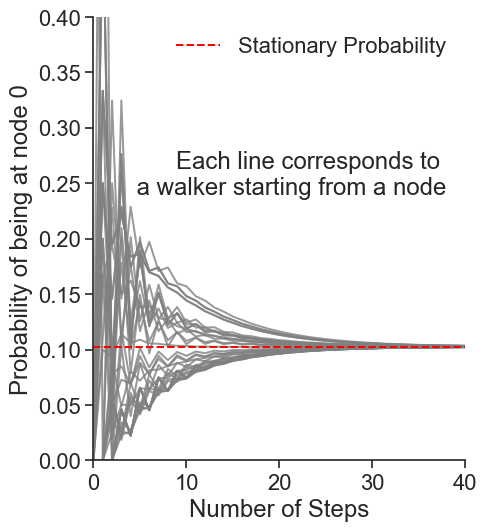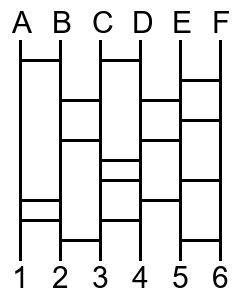
Check list
Advanced Topics in Network Science
Lecture 07: Random Walks Sadamori Kojaku
What to Learn 📚
- 🎲 Random walks as a powerful tool in network analysis
- 🧮 Characterization of random walks in networks
- 🌟 Steady state distribution, and dynamic behavior
- 🔗 Connection to centrality measures and community detection
Have you ever played this game? 🎮

Ladder Lottery Game 🪜
- Choose a line.
- Move along the line, cross the horizontal lines if you hit them.
- Stop at the end of the line.
- You’ll win if you hit a treasure at the end of the line.
Suppose you know where is the treasure is located. Think a strategy to maximize your winning probability 🤔.


Answer
- Choose the line above the treasure.
Why?
- Suppose that there is no horizontal line. You’ll win if you choose the line above the treasure.
- Now, consider adding few horizontal lines. You’ll only move other lines few times, and you’ll end up with being on the line centered around the treasure with high probability.
- The chance of winning “diffuses” as the number of horizontal lines increases, with limit close to uniform.
This is a network!
Random Walks in Networks 🌐
- 🚶♀️ Simple process: Start at a node, randomly move to neighbors
- 🏙️ Analogy: Drunk person walking in a city
- Interestingly, this random process captures many important properties of networks
- Unifies different concepts in network science, e.g., centrality, community structure

Interactive Demo: Random Walk
- When the random walker makes many steps, where does it tend to visit most frequently?
- When the walker makes only a few steps, where does it tend to visit?
- Does the behavior of the walker inform us about centrality of the nodes?
- Does the behavior of the walker inform us about communities in the network?
Pen and Paper (and a bit of coding) Exercises ✍️
Mathematical Foundations of Random Walks 🧮
Transition Probability Matrix 📊
Transition probability
\[ P_{ij} = \frac{A_{ij}}{k_i} \]
where \(A_{ij}\): Adjacency matrix element, and \(k_i\): Degree of node \(i\).
In matrix form
\[ \mathbf{P} = \mathbf{D}^{-1}\mathbf{A} \]
where \(\mathbf{D}\): Diagonal matrix of node degrees.

Stationary Distribution 📈
Let us consider a random walk on an undirected network starting from a node. After sufficiently many steps, where will the walker be?
Let \(x_i(t)\) be the probability that a random walker is at node \(i\) at time \(t\).
After many steps, \(\lim_{t\to\infty} x_i(t) = \pi_i\), which is time invariant, \(\pi_i\) is called the stationary distribution
At stationary state,
\[ {\bf \pi} = {\bf \pi P} \]
What is the solution?
Stationary Distribution
This is the eigenvalue problem.
\[ {\bf \pi} = {\bf \pi P} \]
One of the left-eigenvector of \({\bf P}\) is the stationary distribution
Question: - There are \(N\) left-eigenvectors for a network with \(N\) nodes. Which one represents the stationary distribution?
Coding Exercise:
Create a karate-club graph.
import igraph as ig
import numpy as np
g = ig.Graph.Famous("Zachary") # Load the Zachary's karate club network
A = g.get_adjacency_sparse() # Get the adjacency matrixTask 1: Create a line plot of the probability distribution of the random walker over the nodes as a function of the number of steps. Create the plot for walkers starting from node 0, 32, or 6.
Task 2: Compute the stationary distribution using the eigenvector problem \({\bf \pi} = {\bf \pi P}\). You may want to use np.linalg.eig to compute the (left) eigenvectors and eigenvalues of the matrix \({\bf P}\).
Task 3: Compare the stationary distribution with the degree distribution.
Transient state
Transient State
Transient state captures the local structure around the starting node.
- e.g., community structure, cycles, degree assortativity, etc.
When does the transient state end?
👉 Mixing Time
- \(t_{\text{mix}} = \min\{t : \max_{{\bf x}(0)} \|{\bf x}(t) - {\bf \pi}\|_{1} \leq \epsilon\}\)
Time to reach the stationary distribution within a certain tolerance \(\epsilon\).
Mixing Time
Random walk distribution \({\bf x}(t)\) at time \(t\) is given by
\[ {\bf x}(t) = {\bf x}(0) \mathbf{P}^t. \]
where
- \({\bf x}(0)\): Initial state vector
- \({\bf x}(t)\): State vector at time \(t\)
The mixing time depends on the initial state \({\bf x}(0)\) and \({\bf P}^t\).
The network structure is encapsulated in \({\bf P}\). But this does not tell us what structure in \({\bf P}\) affects the mixing time. 🤔
What’s your expectation?
What network structure affects the mixing time, and in what way?
How does this structure show up in the transition probability matrix \({\bf P}\)?
\[ {\bf x}(t) = {\bf x}(0) \mathbf{P}^t. \]
Let’s arm ourselves with some matrix algebra 🧰
Diagonalizability
Diagonalizable matrix: A matrix \(\mathbf{S}\) is diagonalizable if \({\bf S}\) can be represented as \(\mathbf{S} = \mathbf{Q}\mathbf{\Lambda}\mathbf{Q}^{-1}\), where \(\mathbf{Q}\) is an invertible matrix and \(\mathbf{\Lambda}\) is a diagonal matrix of eigenvalues.

Exercise: Diagonalizabilty helps us to compute a power of a matrix easily. Compute the power \({\bf S}^2\) of diagonalizable matrix \({\bf S} = \mathbf{Q}\mathbf{\Lambda}\mathbf{Q}^{-1}\).
Power of Diagonalizable Matrix
\({\bf S}^2 = \mathbf{Q}\mathbf{\Lambda}\mathbf{Q}^{-1} \mathbf{Q}\mathbf{\Lambda}\mathbf{Q}^{-1} = \mathbf{Q}\mathbf{\Lambda}^2\mathbf{Q}^{-1}\)
In general, \({\bf S}^t = \mathbf{Q}\mathbf{\Lambda}^t\mathbf{Q}^{-1}\)

Is the transition matrix diagonalizable? Yes 🙂!
Let’s introduce a new matrix \(\mathbf{\bar A}\) called the normalized adjacency matrix.
\[ \mathbf{\bar A} = \mathbf{D}^{-\frac{1}{2}} \mathbf{A} \mathbf{D}^{-\frac{1}{2}} \]
\({\bf D}\) is a diagonal matrix of node degrees, i.e.,
\[ \mathbf{D} = \begin{pmatrix} k_1 & 0 & \cdots & 0 \\ 0 & k_2 & \cdots & 0 \\ \vdots & \vdots & \ddots & \vdots \\ 0 & 0 & \cdots & k_N \end{pmatrix} \]
The transition matrix \(\mathbf{P}\) can be rewritten as \[ \begin{aligned} \mathbf{P} &= \mathbf{D}^{-1} \mathbf{A} \\ & = \mathbf{D}^{-\frac{1}{2}} \left( \mathbf{D}^{-1/2} \mathbf{A} \mathbf{D}^{-1/2} \right) \mathbf{D}^{\frac{1}{2}} \\ &= \mathbf{D}^{-\frac{1}{2}} \mathbf{\bar A} \mathbf{D}^{\frac{1}{2}} \end{aligned} \]
Matrix \(\mathbf{\bar A}\) is symmetric (since the network is undirected) and therefore diagonalizable:
\[ \mathbf{\bar A} = \mathbf{Q} \mathbf{\Lambda} \mathbf{Q}^{\top}, \]

where \(\mathbf{\Lambda}\) is a diagonal matrix of eigenvalues, and \(\mathbf{Q}\) is a matrix of eigenvectors of \(\mathbf{\bar A}\).
Let’s express \(\mathbf{P}^2\) using \(\mathbf{D}\), \(\mathbf{Q}\), and \(\mathbf{\Lambda}\).
\[ \begin{aligned} \mathbf{P}^2 &= \left( \mathbf{D}^{-\frac{1}{2}} {\bf \overline A} \mathbf{D}^{\frac{1}{2}} \right)^2 \\ &= \mathbf{D}^{-\frac{1}{2}} \mathbf{\overline A} \mathbf{D}^{\frac{1}{2}} \mathbf{D}^{-\frac{1}{2}} \mathbf{\overline A} \mathbf{D}^{\frac{1}{2}} \\ & = \mathbf{D}^{-\frac{1}{2}} {\bf \overline A}^2 \mathbf{D}^{\frac{1}{2}} \\ &= \underbrace{\mathbf{D}^{-\frac{1}{2}} \mathbf{Q}}_{{\bf Q}_L} {\bf \Lambda}^2 \underbrace{\mathbf{Q}^\top \mathbf{D}^{\frac{1}{2}}}_{{\bf Q}^\top _R}\\ \end{aligned} \]
where we defined:
\[ {\bf Q}_L = \mathbf{D}^{-\frac{1}{2}} \mathbf{Q}, \quad {\bf Q} _R = \mathbf{D}^{\frac{1}{2}} \mathbf{Q} \]
Question: What would you get by computing the product \({\bf Q}_L ^\top {\bf Q}_R\)?
Transition matrix is diagonalizable
\[ {\bf Q}_L ^\top {\bf Q}_R = \mathbf{I} \]
So the transition matrix \(\mathbf{P}\) is diagonalizable 🙂!
\[ \mathbf{P} = {\bf Q}_L \mathbf{\Lambda} \mathbf{Q}_R \]
where
\[ {\bf Q}_L = \mathbf{D}^{-\frac{1}{2}} \mathbf{Q}, \quad {\bf Q} _R = \mathbf{D}^{\frac{1}{2}} \mathbf{Q} \]
with \(\mathbf{Q}_R \mathbf{Q}_L^{-1} = \mathbf{I}\). This means that
\[ {\bf P}^t = {\bf Q}_L \mathbf{\Lambda}^t \mathbf{Q}_R \]
Mixing Time
Let’s put \({\bf P}^t = {\bf Q}_L \mathbf{\Lambda}^t \mathbf{Q}_R\) into the random walk equation:
\[ \begin{aligned} {\bf x}(t) &= {\bf x}(0) \mathbf{P}^t \\ &= {\bf x}(0) \mathbf{Q}_L \mathbf{\Lambda}^t \mathbf{Q}_R \end{aligned} \]
In element-wise, we have
\[ \begin{pmatrix} x_1(t) \\ x_2(t) \\ \vdots \\ x_N(t) \end{pmatrix} = \sum_{\ell=1}^N \left[ \lambda_\ell^t \langle\mathbf{q}^{(R)}_{\ell}, \mathbf{x}(0) \rangle \begin{pmatrix} q^{(L)}_{\ell 1} \\ q^{(L)}_{\ell 2} \\ \vdots \\ q^{(L)}_{\ell N} \end{pmatrix} \right] \]

Mixing Time
\[ \begin{pmatrix} x_1(t) \\ x_2(t) \\ \vdots \\ x_N(t) \end{pmatrix} = \sum_{\ell=1}^N \left[ \color{red}{\lambda_\ell^t} \langle\mathbf{q}^{(R)}_{\ell}, \mathbf{x}(0) \rangle \begin{pmatrix} q^{(L)}_{\ell 1} \\ q^{(L)}_{\ell 2} \\ \vdots \\ q^{(L)}_{\ell N} \end{pmatrix} \right] \]
- \(\lambda_i \leq 1\) (the blue balls) with equality holds for the largest eigenvalue \(\lambda_1 = 1\).
- When \(t \rightarrow \infty\), only the largest eigenvalue \(\lambda_1\) survives
- Other eigenvalues \(\lambda_i\) decay exponentially as \(t\) increases
- The second largest eigenvalue \(\lambda_2\) most significantly affects the mixing time.
Mixing Time and Relaxation Time
The relaxation time \(\tau\) is given by
\[ \tau = \frac{1}{1-\lambda_2} \]
where \(\lambda_2\) is the second largest eigenvalue of the normalized adjacency matrix \(\mathbf{\bar A}\).
Relaxation time \(\tau\) is a convenient reference for the mixing time, as it bounds the mixing time.
\[ t_{\text{mix}} < \tau \log \left( \frac{1}{\epsilon \min_{i} \pi_i} \right) \]
Coding Exercise
Task 1: Construct the adjacency matrices of two graphs as follows:
Task 2: Compute the normalized adjacency matrix \({\bf \overline A} = \mathbf{D}^{-\frac{1}{2}} \mathbf{A} \mathbf{D}^{-\frac{1}{2}}\), where \(\mathbf{D}\) is the degree diagonal matrix.
Task 3: Compute the relaxation time \(\tau = \frac{1}{1-\lambda_2}\) using the second largest eigenvalue \(\lambda_2\) of the normalized adjacency matrix.
Relationship between Random Walks, Modularity, and Centrality 🌟
https://skojaku.github.io/adv-net-sci/m07-random-walks/unifying-centrality-and-communities.html